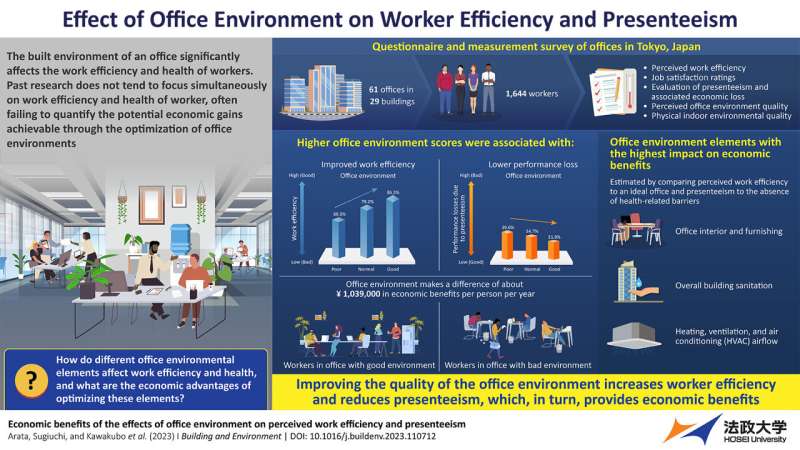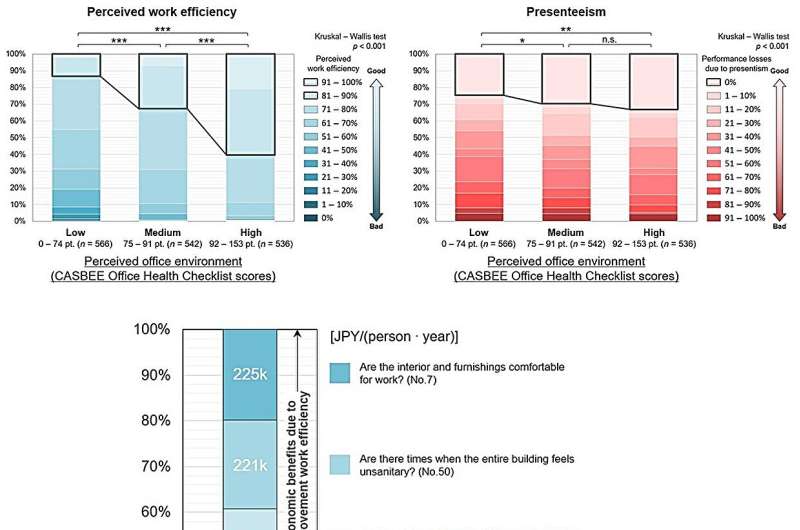This article has been reviewed according to Science X's editorial process and policies. Editors have highlighted the following attributes while ensuring the content's credibility:
fact-checked
proofread
Optimizing office environments for work efficiency and worker health

The quality of the office environment significantly affects work efficiency and worker health. Therefore, creating and maintaining an optimal built environment in the office can be a key step in maximizing a company's economic growth.
Previous research has examined how indoor environmental quality (IEQ), including elements like temperature, air quality, lighting, and noise, impacts work efficiency and worker health. However, these studies do not tend to focus simultaneously on work efficiency and worker health, nor do they quantify the economic benefits of optimizing office environments.
In a new study published in the journal Building and Environment, researchers from Japan investigated how office environmental elements impact work efficiency and worker health, while also analyzing the economic benefits of optimizing these elements.
They surveyed 1,644 workers in 29 office buildings in Tokyo, collecting data on the built environment through worker questionnaires and physical IEQ measurements. They then compared the perceived work efficiency (reported by workers) in offices to that in an 'ideal' office with maximum work efficiency to estimate the economic value provided by the built environment.
Similarly, they looked at the extent of presenteeism (working while sick) and compared it to a scenario where workers faced no health-related barriers to work. The study, led by Professor Shun Kawakubo from the Faculty of Engineering and Design at Hosei University, Japan, included colleagues Shiro Arata and Masaki Sugiuchi from Hosei University, and others.
The study found that participants perceived their work efficiency to be at an average of approximately 77%. Presenteeism varied, with some participants reporting no symptoms in the last 30 days, while others experiencing symptoms every day. The average decrease in performance due to presenteeism was approximately 34%.

The effects of overall office environment elements on perceived work efficiency and presenteeism were examined in the study. A better overall office environment was associated with higher perceived work efficiency among workers.
"Workers in offices with lower environmental performance had low work efficiency, while those in higher-performing offices had high work efficiency. The 16.8-point difference in work efficiency between workers in offices with relatively good and poor environments equates to an annual economic benefit of about 1,039,000 JPY, highlighting the financial advantages of a good work environment," explains Prof. Kawakubo.
Similarly, a better overall office environment was linked to lower performance loss due to presenteeism. Prof. Kawakubo notes, "The better the office environment, the lower the amount of loss due to presenteeism. The difference in annual economic loss due to presenteeism between workers in offices with relatively low environmental performance and workers in offices with relatively high environmental performance was 423,000 JPY."
The study also revealed that higher quality elements such as "interior and furnishings," "overall building sanitation," "airflow from HVAC (heating, ventilation, and air conditioning)," and "meeting space" were associated with higher perceived work efficiency. Elements like "disaster and emergency," "thermal environment," "lightning environment," and "telecommunication networks" were associated with lower economic losses due to presenteeism. The estimated economic benefits related to perceived work efficiency were greater than those associated with presenteeism.
The study concludes that offices can boost economic benefits, and underscores the global need for enhancing worker efficiency as well as employee health by developing good quality offices.
"Today, companies around the world are reaffirming the importance of human capital. We believe that widespread recognition of the fact that investment in the creation of a good office environment is directly linked to maintaining and improving the health of office workers and increasing the productivity of the company as a whole, will contribute to the building of a healthier society," concludes Prof. Kawakubo.
More information: Shiro Arata et al, Economic benefits of the effects of office environment on perceived work efficiency and presenteeism, Building and Environment (2023). DOI: 10.1016/j.buildenv.2023.110712
Provided by Hosei University




















